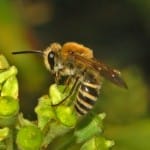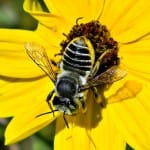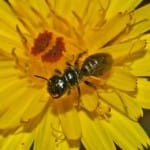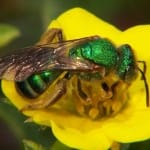Source(s):
- S. Bambara, Extension Entomologist, North Carolina State University, North Carolina Cooperative Extension Service.
- R. Brandenburg, Extension Entomologist, North Carolina State University, North Carolina Cooperative Extension Service.
- J. Baker, Extension Entomologist, North Carolina State University, North Carolina Cooperative Extension Service.
There are many common species of solitary bees which nest in individual holes in the ground. The bees range in size from 1/2″-3/4″, and may be a variety of colors such as blue, green, copper or metallic red. They may belong to one of several groups of bees, such as the membrane bees, digger bees, sweat bees, leafcutter bees and mason bees or other groups (Colletidae, Andrenidae, Halictidae, Megachilidae) and may occur across the state.
Introduction
Females excavate nesting tubes during the evening hours which reach six or more inches in depth. Tubes are lined with a water-proofing secretion for protection from moisture. Small mounds of excavated soil may appear around each nest opening. When bees are numerous, many holes may be in close proximity, creating a “city-like” aggregation. Each hole belongs to a separate tube. During the day, the active females collect pollen and nectar to carry back to the nest to form a “ball” 1/8″-1/4″ in diameter. A single egg is laid upon the pollen ball in March, April, or early May.
After hatching, the larva feeds on the pollen and develops within the tube until it reaches adulthood in the fall. The adult remains in the borrow throughout the winter until emergence from the ground in March or April. At this time, mating takes place and bee activity begins to pick up as the nesting cycle resumes. Though adult bees feed on nectar, none store honey, as such. Solitary, ground nesting bees play a vital role in ecological systems, especially in pollination of crops and wild plants, and they should not be destroyed casually.
Damage
Ground nesting bees generally prefer nesting in areas with morning sun exposure and well drained soils containing little organic matter. Tunnels are excavated in areas of bare ground or sparse vegetation and damp soils are avoided. Damage to lawns and turf is usually minimal and control is often sought because the bees are perceived as a danger or annoyance.
Solitary bees rarely sting and there is no mass attack as might be found with honey bees. Outdoor activities, including lawn mowing, can often be continued with no problem. However, with very large aggregations, one may prefer to avoid the area for 4-6 weeks while the nesting is taking place.
Pest Management
Cultural control methods include heavy watering or irrigation with a lawn sprinkler during the nest-building period to discourage nesting behavior. Tilling of soil to destroy tunnels may help a little, but establishment of dense turf is probably the best discouragement to further nesting. Applications of heavy organic matter could be included as a soil amendment, if practical, when tilling the soil. If the soil or location is not conducive to a healthy lawn, using ground covers or heavy mulches may be an alternative solution. Mulches may be used on bare patches caused by heavy traffic where grass will not grow.
Chemical Treatment
If chemical treatment is desired, the following insecticides may be used by the homeowner. Mix the desired chemical with the appropriate amount of water and spray enough to wet soil at and around nest openings.
Chemical Formulation Treatment Rate
carbaryl (Sevin) 50% wettable powder (50WP) 8 oz./1000 sq. ft.
Recommendations for the use of chemicals are included in this publication as a convenience to the reader. The use of brand names and any mention or listing of commercial products or services in this publication does not imply endorsement by The University of Georgia Cooperative Extension nor discrimination against similar products or services not mentioned.
Center Publication Number: 201



